





I'll bet you have never even heard of Medlar, much less eaten one. It has been popular enough in the past to place it among the food items considered de rigueur for medieval and Renaissance-era banquets and feasts put on by the local Society for Creative Anachronism, an international organization dedicated to the arts and skills of pre-17th century Europe.[1] Shakesphere mentions the Medlar in more than one play and Caravaggio included it in his 1592 painting, Boy With A Basket of Fruit.
(Editor's Note: This article was originally published on February 5, 2008)
The medlar, Mespilus germanica, is a member of the rose family and is botanically somewhere between a pear and a Hawthorne. The Medlar is a small, deciduous tree of about 20 feet in height and width with a broad crown and heavy foliage. The branches may be contorted or very angular and the wild varieties may have thorns. It is hardy to USDA zone 4 to 9 and grows wild in temperate regions of Europe. It is reported to be indigenous to southwest Asia and southeastern Europe and was introduced to Germany by the Romans. It is said that Medlars were taken to North America by the Jesuits in the 1800s and introduced to South Africa in the 17th century.
Francesca Greensack in her fascinating book "Forgotten Fruit" said, "the lingering, slightly sweet, slightly winey flavor makes the Medlar seem like a natural comfit". She also mentioned "roasting them with butter and cloves as a traditional winter dessert" and recommends jelly made from them "as an accompaniment to game"."[3] Medlars like moist but well-drained soil, and full sun and adapt to soil fertility. Medlars can be grown from seed or grafted or budded onto pear, quince or hawthorn rootstock. There are about two dozen cultivars at the National Clonal Germplasm repository of the U.S. department of agriculture in Corvallis, Oregon and others growing wild in Europe. They are considered easy to grow but a bit difficult to start from seed. They work well as a potted "patio" tree if left outside and exposed to winter conditions. The tree fruits as early as three years, producing a good crop. The wood of the slow growing Medlar tree is hard, even, fine grained and polishes well and is reported to be practically unbreakable. The wood is not used for lumber as the tree stays relatively small and the branches are not necessarily straight. Because the wood is rather hard, it has been used for spear points, hunting and warfare clubs and fighting sticks and making windmill parts, especially some of the turning wheels. [6] The Basque people use the wild Medlar to make their traditional Makhila which is both a walking stick and a defensive weapon. Reports of medicinal uses for Medlar are scanty. I did find a single recommendation of a remedy for kidney stones that proposes that Medlar leaves be boiled and drunk as tea until the stone is ejected. Although the fruit is edible, it is not considered GRAS (Generally Recognized as Safe). In addition, like many members of the Rosaceae family, the seeds contain hydro-cyanic acid (prussic acid) and may be toxic if eaten. [2] The USDA repository in Corvallis, OR may have limited amounts of medlar scion wood available that can be grafted onto a variety of rootstock including, quince, Hawthorne and pear. Mailorder nurseries specializing in edible landscaping and/or rare fruits including Raintree, One Green World, and Edible Landscaping.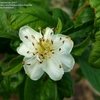
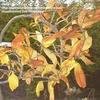 The foliage is quite showy in the fall with yellow or red leaves. The fruit, if left on the tree creates winter interest. The leaves are 2 to 6 inches long and 1 to 1 1/2 inches wide, alternate, elliptic, dark green in the upper surface, "hairy" and grayish beneath. The leaf margin is entire, serrated at the apex. The trees dense foliage hides the branches. The solitary flowers appear at the tip of the growth of the year, depending on the location from late April to early June. The five petaled flowers are 1 to 2 inches wide, pinky white and look to me like something like a wild rose. Medlars are self-fertile and if pollination should not occur, the Medlar can set fruit parthenocarpically, that is, without
The foliage is quite showy in the fall with yellow or red leaves. The fruit, if left on the tree creates winter interest. The leaves are 2 to 6 inches long and 1 to 1 1/2 inches wide, alternate, elliptic, dark green in the upper surface, "hairy" and grayish beneath. The leaf margin is entire, serrated at the apex. The trees dense foliage hides the branches. The solitary flowers appear at the tip of the growth of the year, depending on the location from late April to early June. The five petaled flowers are 1 to 2 inches wide, pinky white and look to me like something like a wild rose. Medlars are self-fertile and if pollination should not occur, the Medlar can set fruit parthenocarpically, that is, without  any pollination whatsoever.
any pollination whatsoever.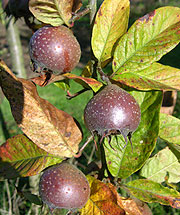 The fruit is round, one to two inches in diameter looking somewhat like a brown, over-grown rose hip with a calyx on its crown. The fruit is open at the bottom exposing five seed boxes. The uniqueness of the fruit comes from the fact that it must be nearly rotten to be edible. (And now you know why you have never heard of it!) The process of "ripening" the fruit is referred to as bletting which takes 2 to 3 weeks in storage. The fruit becomes soft, mushy brown, sweet and tasty with a flavor described as close to cinnamon applesauce. Medlars are a fruit that can be eaten fresh in the winter. Poking a hole in the fruit and sucking out the bletted (let's not say rotted) flesh spitting out the smooth seeds is one way to experience the unique taste of Medlar.
The fruit is round, one to two inches in diameter looking somewhat like a brown, over-grown rose hip with a calyx on its crown. The fruit is open at the bottom exposing five seed boxes. The uniqueness of the fruit comes from the fact that it must be nearly rotten to be edible. (And now you know why you have never heard of it!) The process of "ripening" the fruit is referred to as bletting which takes 2 to 3 weeks in storage. The fruit becomes soft, mushy brown, sweet and tasty with a flavor described as close to cinnamon applesauce. Medlars are a fruit that can be eaten fresh in the winter. Poking a hole in the fruit and sucking out the bletted (let's not say rotted) flesh spitting out the smooth seeds is one way to experience the unique taste of Medlar. 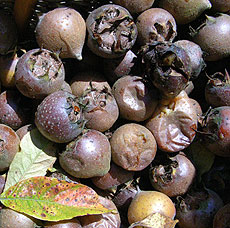
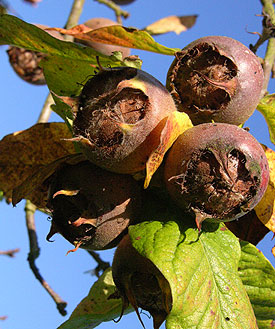 They can also be cooked into jellies and jams as they are high in pectin. "But it has long been regarded as a dessert fruit for connoisseurs. Prof. Saintsbury in his classic book on wines, "Notes on a Cellar", declared that "the one fruit which seems to me to go best with all wine, from hock to sherry and from claret to port, is the Medlar - an admirable and distinguished thing in itself, and a worthy mate for the best of liquors".
They can also be cooked into jellies and jams as they are high in pectin. "But it has long been regarded as a dessert fruit for connoisseurs. Prof. Saintsbury in his classic book on wines, "Notes on a Cellar", declared that "the one fruit which seems to me to go best with all wine, from hock to sherry and from claret to port, is the Medlar - an admirable and distinguished thing in itself, and a worthy mate for the best of liquors".
Other Uses for the Medlar Tree
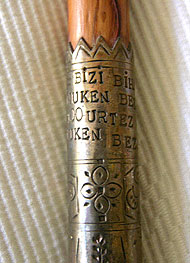 The unique process starts with carving lines on a living branch of a tree that is at least 15 years old in the spring and harvesting the branch in the winter.
The unique process starts with carving lines on a living branch of a tree that is at least 15 years old in the spring and harvesting the branch in the winter. 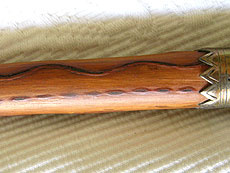 Over the summer the design of the carving has expanded with the growth of the tree. The bark is removed and the branch straightened with the heat of a kiln which takes a great deal of skill. The wood is then allowed to dry naturally for several years. The wood is then colored using guarded family techniques. The stick is finished with made-to-measure decorative fittings which are cut, carved, braced and decorated pieces of brass, silver, german silver or gold. The handle is either metal or garnished with woven leather straps and finished with a horn or worked metal pommel. The handle unscrews to reveal a forged metal spike which can be used for walking or defense.[4] Traditional makhila are inscribed with a short verse of the owners own symbolism in the arcane Basque language. The making of a makhila is a tradition passed down from Father to Son and there are only very few makhila makers left.
Over the summer the design of the carving has expanded with the growth of the tree. The bark is removed and the branch straightened with the heat of a kiln which takes a great deal of skill. The wood is then allowed to dry naturally for several years. The wood is then colored using guarded family techniques. The stick is finished with made-to-measure decorative fittings which are cut, carved, braced and decorated pieces of brass, silver, german silver or gold. The handle is either metal or garnished with woven leather straps and finished with a horn or worked metal pommel. The handle unscrews to reveal a forged metal spike which can be used for walking or defense.[4] Traditional makhila are inscribed with a short verse of the owners own symbolism in the arcane Basque language. The making of a makhila is a tradition passed down from Father to Son and there are only very few makhila makers left.Where Can You Find a Medlar Tree?
Copyright © www.100flowers.win Botanic Garden All Rights Reserved